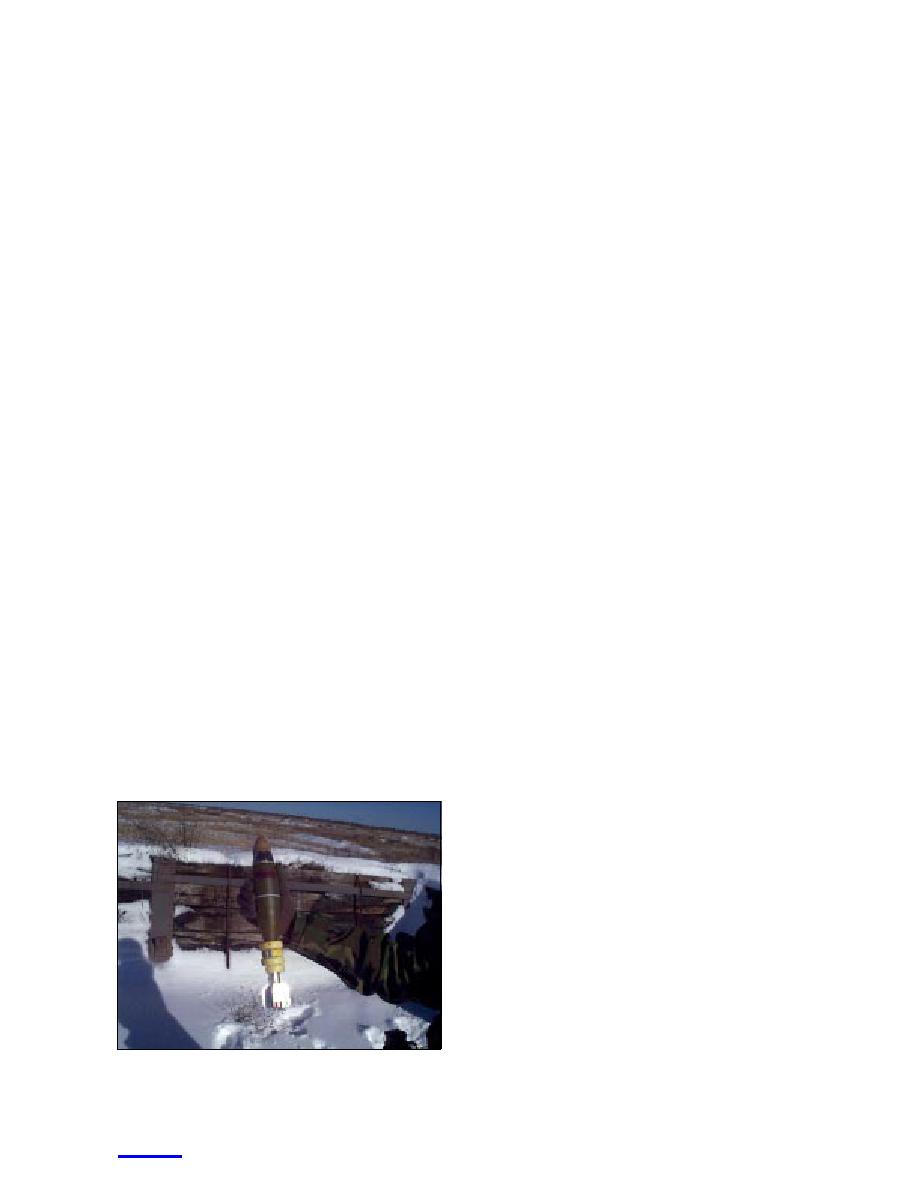
The total volume of snowmelt was measured. To
able. A light wind from the northwest coincided with
extract the explosives from the water, we placed a 1520-
the trajectory of the mortar rounds.
mL aliquot in a 2-L volumetric flask containing 496 g
Two of the three mortar rounds landed in areas that
of sodium chloride (Miyares and Jenkins 1991, USEPA
were accessible for surface sampling. The third round
1994). A magnetic stir bar was placed in the flask, and
landed in an inaccessible area of large rocks, so only
the contents were stirred to dissolve the salt. A 325-mL
the first two areas were sampled. The surface of the
aliquot of acetonitrile was added, and the flask was
soil under the snow was thawed at the time of this
stirred vigorously for 30 minutes. The magnetic stirrer
experiment, and, unfortunately, this resulted in the
was then turned off and the phases were allowed to sep-
spraying of some soil particles over the snow surface
arate for 30 minutes. The acetonitrile phase on the top,
along with detonation residues.
about 25 mL, was removed. Then, we measured the
Area 1 was sampled about 15 minutes after the round
volume using a graduated cylinder and labeled the sam-
was detonated. The trajectory of firing caused the resi-
ple salting out extract (SOE).
dues to be distributed directionally along the trajectory
To ensure that any explosives residues deposited on
of firing, away from the impact point (Fig. 6a). Surface
the inside of the bags were recovered, the plastic bags
snow samples were collected in the visibly contamin-
were wiped with Whatman filters (two to four per bag)
ated area as described above for Camp Ethan Allen.
and the filters were placed in a Soxhlet extraction thim-
We collected six surface snow samples in a continuous
ble. Then, the Whatman filters that were used on that
line from 1 to 14 m from the impact crater. Surface
areas sampled varied from 1.16 to 3.72 m2. The area
sample were added to the thimble, which was placed
inside a Soxhlet extractor. A 250-mL aliquot of aceto-
where soot was visible on the surface was measured
nitrile was added to the receiver of the Soxhlet extrac-
after all samples were collected so that residues were
tor and the heating mantle turned on. The samples were
not tracked into areas to be sampled. The total debris
plume was estimated at 79 m2 ; the total area sampled
continuously extracted for 22 hours at six cycles per
was 12 m2 or about 15%.
hour. After the solvent cooled, we measured the vol-
ume of the solvent and removed an aliquot for analy-
Area 2 was sampled about an hour after detonation.
sis. This sample was labeled as SOX.
We collected five samples in a continuous line from
1.2 to 9.5 m from the impact crater. The area where
residues were visible was estimated at 58 m2 (Fig. 6b).
Mortar round firing and sample collection
The total area sampled was 7.3 m2 or about 13% of the
at Fort Drum
On the morning of the test, we inspected the snow
total debris plume. The tail fin from each round was
cover on the impact range and selected several areas,
found near the detonation craters. These fins were col-
which we directed the Army team to target. At about
lected to see if explosives residues were detectable on
1000, three 60-mm mortar rounds (Fig. 5) were fired
their surfaces.
into the range and each detonated on impact. After the
Processing of snow samples from Fort Drum
three rounds were fired from the mortar tube, the sur-
face snow (1 m2) just in front of the tube was sampled
Snow was melted as described above, but initial
attempts to filter the snowmelt were frustrated by the
to determine if residues of the propellant were detect-
presence of clay-soil particles. Only five of the sam-
ples were filtered as described above for samples from
Camp Ethan Allen. These five were the firing point sam-
ple, a snow blank collected 100 m from the crater, and
three surface snow samples from area 1 labeled S-1, S-2,
and S-4. It took 40 individual glass fiber filters to pro-
cess the whole of sample S4, requiring over 6 hours.
For this reason the remaining samples from area 1 and
all of the samples from area 2 were processed differ-
ently. For these samples, the bags were shaken vigor-
ously and a 1520-mL aliquot of the sample containing
suspended soot particles was extracted using the salt-
ing out procedure described for the Ethan Allen sam-
ples. For the five samples that were filtered, 1520-mL
aliquots were processed using salting out solvent extrac-
tion, and the filters and bag wipes were extracted using
the Soxhlet method described for the Ethan Allen sam-
Figure 5. A 60-mm mortar round.
5
to contents



 Previous Page
Previous Page
